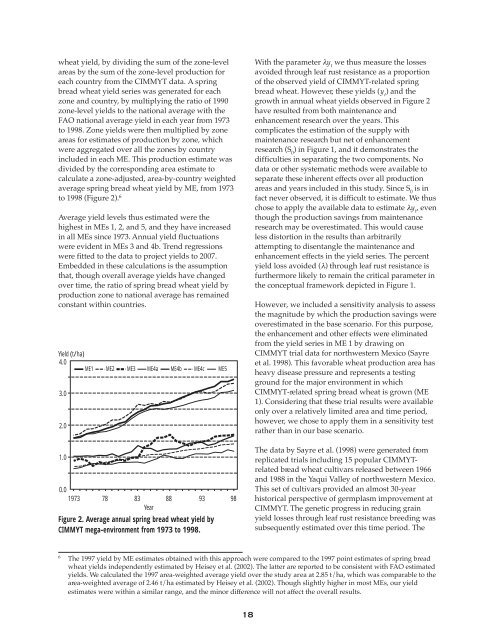The Economic Impact in Developing Countries of ... - AgEcon Search
The Economic Impact in Developing Countries of ... - AgEcon Search
The Economic Impact in Developing Countries of ... - AgEcon Search
- No tags were found...
You also want an ePaper? Increase the reach of your titles
YUMPU automatically turns print PDFs into web optimized ePapers that Google loves.
wheat yield, by divid<strong>in</strong>g the sum <strong>of</strong> the zone-levelareas by the sum <strong>of</strong> the zone-level production foreach country from the CIMMYT data. A spr<strong>in</strong>gbread wheat yield series was generated for eachzone and country, by multiply<strong>in</strong>g the ratio <strong>of</strong> 1990zone-level yields to the national average with theFAO national average yield <strong>in</strong> each year from 1973to 1998. Zone yields were then multiplied by zoneareas for estimates <strong>of</strong> production by zone, whichwere aggregated over all the zones by country<strong>in</strong>cluded <strong>in</strong> each ME. This production estimate wasdivided by the correspond<strong>in</strong>g area estimate tocalculate a zone-adjusted, area-by-country weightedaverage spr<strong>in</strong>g bread wheat yield by ME, from 1973to 1998 (Figure 2). 6Average yield levels thus estimated were thehighest <strong>in</strong> MEs 1, 2, and 5, and they have <strong>in</strong>creased<strong>in</strong> all MEs s<strong>in</strong>ce 1973. Annual yield fluctuationswere evident <strong>in</strong> MEs 3 and 4b. Trend regressionswere fitted to the data to project yields to 2007.Embedded <strong>in</strong> these calculations is the assumptionthat, though overall average yields have changedover time, the ratio <strong>of</strong> spr<strong>in</strong>g bread wheat yield byproduction zone to national average has rema<strong>in</strong>edconstant with<strong>in</strong> countries.Yield (t/ha)4.0ME1 ME2 ME3 ME4a ME4b ME4c ME53.02.01.00.01973 78 83 88 93 98YearFigure 2. Average annual spr<strong>in</strong>g bread wheat yield byCIMMYT mega-environment from 1973 to 1998.With the parameter λy twe thus measure the lossesavoided through leaf rust resistance as a proportion<strong>of</strong> the observed yield <strong>of</strong> CIMMYT-related spr<strong>in</strong>gbread wheat. However, these yields (y t) and thegrowth <strong>in</strong> annual wheat yields observed <strong>in</strong> Figure 2have resulted from both ma<strong>in</strong>tenance andenhancement research over the years. Thiscomplicates the estimation <strong>of</strong> the supply withma<strong>in</strong>tenance research but net <strong>of</strong> enhancementresearch (S 0) <strong>in</strong> Figure 1, and it demonstrates thedifficulties <strong>in</strong> separat<strong>in</strong>g the two components. Nodata or other systematic methods were available toseparate these <strong>in</strong>herent effects over all productionareas and years <strong>in</strong>cluded <strong>in</strong> this study. S<strong>in</strong>ce S 0is <strong>in</strong>fact never observed, it is difficult to estimate. We thuschose to apply the available data to estimate λy t, eventhough the production sav<strong>in</strong>gs from ma<strong>in</strong>tenanceresearch may be overestimated. This would causeless distortion <strong>in</strong> the results than arbitrarilyattempt<strong>in</strong>g to disentangle the ma<strong>in</strong>tenance andenhancement effects <strong>in</strong> the yield series. <strong>The</strong> percentyield loss avoided (λ) through leaf rust resistance isfurthermore likely to rema<strong>in</strong> the critical parameter <strong>in</strong>the conceptual framework depicted <strong>in</strong> Figure 1.However, we <strong>in</strong>cluded a sensitivity analysis to assessthe magnitude by which the production sav<strong>in</strong>gs wereoverestimated <strong>in</strong> the base scenario. For this purpose,the enhancement and other effects were elim<strong>in</strong>atedfrom the yield series <strong>in</strong> ME 1 by draw<strong>in</strong>g onCIMMYT trial data for northwestern Mexico (Sayreet al. 1998). This favorable wheat production area hasheavy disease pressure and represents a test<strong>in</strong>gground for the major environment <strong>in</strong> whichCIMMYT-related spr<strong>in</strong>g bread wheat is grown (ME1). Consider<strong>in</strong>g that these trial results were availableonly over a relatively limited area and time period,however, we chose to apply them <strong>in</strong> a sensitivity testrather than <strong>in</strong> our base scenario.<strong>The</strong> data by Sayre et al. (1998) were generated fromreplicated trials <strong>in</strong>clud<strong>in</strong>g 15 popular CIMMYTrelatedbread wheat cultivars released between 1966and 1988 <strong>in</strong> the Yaqui Valley <strong>of</strong> northwestern Mexico.This set <strong>of</strong> cultivars provided an almost 30-yearhistorical perspective <strong>of</strong> germplasm improvement atCIMMYT. <strong>The</strong> genetic progress <strong>in</strong> reduc<strong>in</strong>g gra<strong>in</strong>yield losses through leaf rust resistance breed<strong>in</strong>g wassubsequently estimated over this time period. <strong>The</strong>6<strong>The</strong> 1997 yield by ME estimates obta<strong>in</strong>ed with this approach were compared to the 1997 po<strong>in</strong>t estimates <strong>of</strong> spr<strong>in</strong>g breadwheat yields <strong>in</strong>dependently estimated by Heisey et al. (2002). <strong>The</strong> latter are reported to be consistent with FAO estimatedyields. We calculated the 1997 area-weighted average yield over the study area at 2.85 t/ha, which was comparable to thearea-weighted average <strong>of</strong> 2.46 t/ha estimated by Heisey et al. (2002). Though slightly higher <strong>in</strong> most MEs, our yieldestimates were with<strong>in</strong> a similar range, and the m<strong>in</strong>or difference will not affect the overall results.18
















